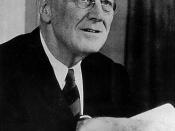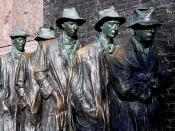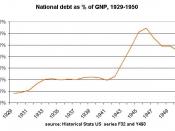The Depression was blamed for destroying the American families, but in many cases the Depression actually caused families to pull together. In 1936 and 1937 the hardships of depression were compounded by a natural disaster in the arid regions of Oklahoma, Texas, Kansas and Arkansas, due to topsoil erosion and Dust Storms as depicted in The Grapes of Wrath.
The Great Depression was widespread throughout the entire country. American factories remained producing goods, but they stood silent because no one could afford to buy the goods.
Business and the Republican party which took credit for the heady days of prosperity now took the blame for the depression and shantytowns were called Hoovervilles, newspapers were used as blankets, people slept on park benches, in boxcars in subways and on the streets and heating vents.
Hoover entered the White House in 1929 as the great humanitarian but when year later he was the torturer of the American people.
As President, the suffering of the American people moved him, so much that he gave a lot of his income to charity.
Something had to be done and many people that lived through the depression of the 1890's didn't want to see the same amount of terror and social conflict.
Hoover did spend $500 million on improving government properties and these projects did create some jobs. The most famous of them was the Boulder Dam now called the Hoover Dam outside Las Vegas.
Hoover led the creation of the Reconstruction Finance Corporation in 1932, which was an agency to help banks railroads and other economic institutions stay in business.
He also cut consumer taxes, but this did nothing for the unemployed.
The Reconstruction Finance Corporation was an unpopular program and people saw it not as a recovery policy but as relief for big business...


